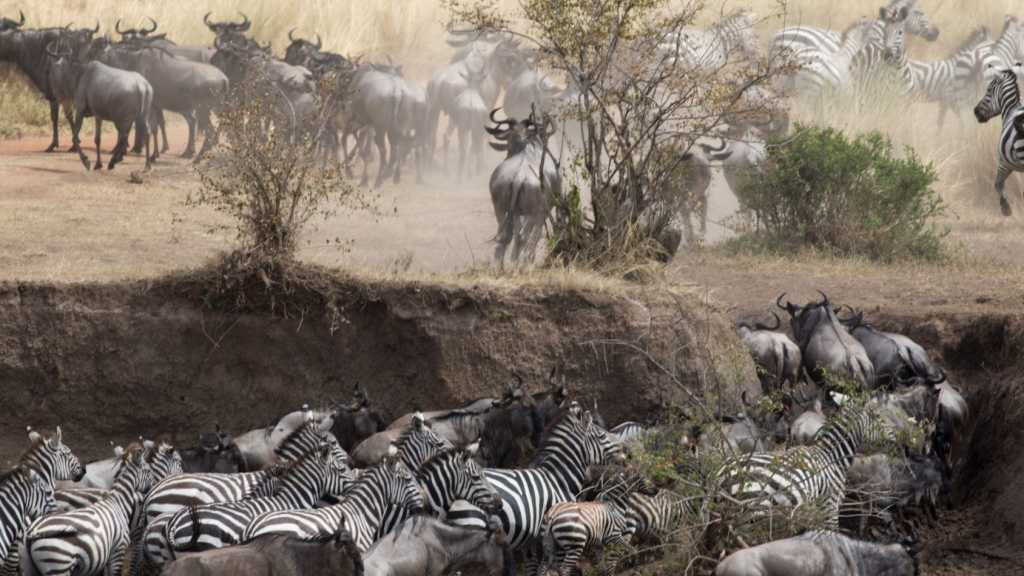Covering an area of 14,763 km2, adjacent to Ngorongoro in the southeast and Masai Mara (Kenya) in the north, it is one of the largest parks in Africa and surely the best known in the world for its wildlife. Its diversified ecosystem allows the grouping of almost all African animal species.
It is the scene of one of the greatest wild animal shows in the world: the great annual migration of wildebeest and zebra.
Its resident population is composed of lions (2,500 concentrated in the plains), cheetahs, leopards, hyenas, elephants, hippos, giraffes, antelopes and birds.
The park can be divided into 3 sections:
- In the South-East, the popular Seronera Valley is what the Maasai called "Siringet", the land of the "endless plains". It is a classic savannah, dotted with acacias, kopjes (rocky promontories) and many streams, perfect for safaris.
- The Western corridor is marked by the Grumeti River, and its vegetation is forests and dense bushes.
- The Northern Lobo region, a forested area, joins the Masai Mara Reserve in Kenya. It is the least visited section, because of its distance (transfer by light aircraft possible) and its more expensive cost for housing.
- The discovery of the protected site of Ngorongoro requires 4x4 vehicle with sunroof only : minibuses are prohibited.
- The visit of the museum of the Olduvai Gorge in the protected area of Ngorongoro offers a nice cultural and historical break between 2 safaris...
- While it is technically possible to visit the parks with its own vehicle without going through an agency, the poor savings made do not compensate for the comfort and the light-heartedness of those who delegate logistics: entry into the parks, animal tracking knowledge, fuel containers...
- Each area of the Serengeti National Park deserves at least half a day safari, which means that a minimum of two to three days is required to visit the whole park.
- The Great Migration within the Serengeti moves all year round. Ask to know the best places according to the chosen period.
Tanzania, the African pearl
Ten million years ago the tectonic forces formed the great fault of the Rift. It was then that landscapes were sculpted over millennia and life began. Indisputable wild sanctuary, Tanzania can boast of possessing the greatest concentration of animals on earth. Conscious of this asset, it devotes 25% of its area to national parks and reserves. To this is added Zanzibar, an enchanting and bewitching island, bordered by miles of white sand and rocked by history.
When to go ?
Tanzania has a generally comfortable tropical climate year-round, although there are significant regional variations.
- Along the warmer and humid coast, the climate is determined in large part by the monsoon winds, which bring rains in two major periods.
- During the long rain season, from mid-March to May, it rains heavily almost every day, although seldom for the whole day, and the air can get unpleasantly sticky.
- During the short rain season during November, December and sometimes into January, the rain is lighter.
The best times to visit Zanzibar are from July to October and from December to March.
Formalities
- A passport valid for at least 6 months from the date of arrival in Tanzania is required by the Tanzanian authorities.
- The visa application must be submitted to the Tanzanian Embassy in the country of residence. However, when the traveller does not have the possibility to apply for a visa before departure, he can obtain it at certain border posts (to be paid in US Dollars):
- At the international airport of Dar es Salaam, Zanzibar and Kilimanjaro
- At the ports of Dar es Salaam, Zanzibar and Kigoma
Health
- No vaccination is mandatory but some vaccinations are recommended; Yellow fever vaccination is mandatory for all travellers from a country where endemic yellow fever is present but may be advised to all travellers. To avoid any inconvenience, it is strongly recommended to be up to date for yellow fever vaccination and to be in possession of an international vaccination booklet.
- Antimalarial treatment is recommended (see your doctor).
Currency
The monetary unit is the Tanzanian shilling (TSH) which is divided into 100 cents.
Credit cards are only accepted in certain hotels and restaurants in major cities. Travellers checks are very difficult to change. It is therefore strongly recommended to bring in foreign currency. Most payments can be made directly in US dollars from series after 2006. Banks and foreign exchange offices realize the exchange of your currencies. Never change money from intermediaries in the street, but only in exchange offices and banks.
Attention: Park fees as well as some lodges and hotel must be paid in US$.
